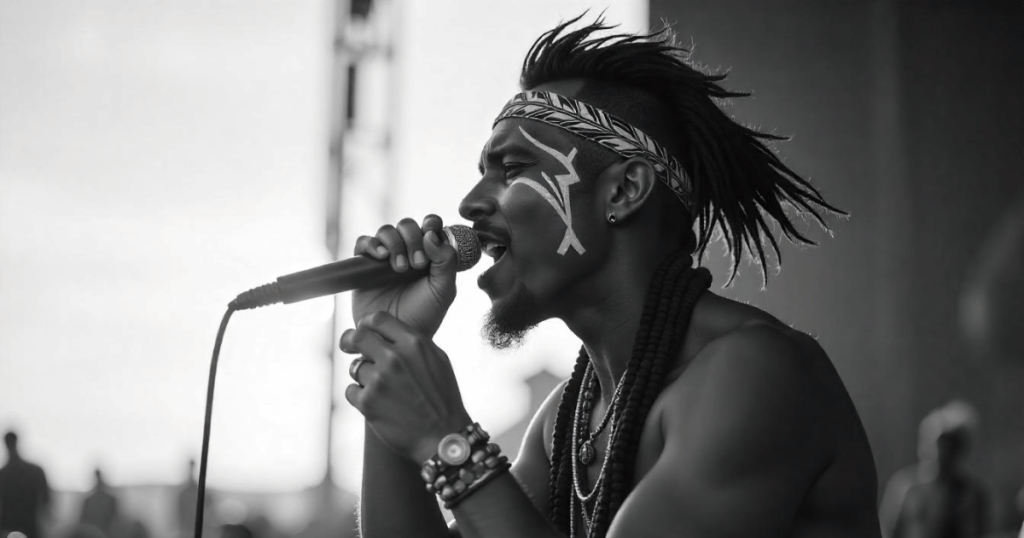It hits you like a shot of adrenaline in a midnight alley—an unexpected beat, raw and unapologetic, that severs the ties to yesterday’s sanitized soundscapes. This isn’t a love letter to polished perfection; it’s a rallying cry, an incantation for those who live on the fringes of culture. Welcome to the murky, pulsing underworld of trap type music—a universe where trap beats and the myriad flavors of trap instrumental expression become more than mere descriptors. They’re the very language of rebellion, the pulse of a generation determined to dismantle the status quo. And if you’re ready to dive into this kinetic world, start your journey at Beats To Rap On. They’re the very language of rebellion, the pulse of a generation determined to dismantle the status quo.
A Collision of Chaos and Craft
In a world where the cookie-cutter pop star hums under studio lights, trap type music emerges as a disruptive beast. Picture this: a dark urban night punctuated by the crisp snap of trap beats, a call to arms for those who reject mainstream packaging. It’s a fusion of smoky, late-night confessions and the digital din of urban life—a genre that’s both a soundtrack for the underdog and a manifesto for the disenchanted. For those who hunger for raw authenticity, there’s no better starting point than BeatStorapon’s homepage, where every beat tells a story.
From the neon-drenched corners of Atlanta to the pulsating heart of underground studios, trap type music is a living, breathing organism. It’s part philosophy, part sonic experiment, and entirely unafraid to rewrite the rules. And as we peel back the layers of this sonic revolution, we find contradictions that are as intricate as the beats themselves—an aesthetic that is at once meticulously constructed and deliciously chaotic.
The Evolution of Trap Type Music: A Sonic Mutiny
When you hear trap beats, you’re not just hearing a style—you’re feeling a seismic shift. This isn’t the era of generic loops and predictable cadences; trap type beats have morphed into a phenomenon that’s redefining musical expression. Look back and see how this genre evolved from the smoky corners of southern hip-hop clubs, where pioneers like T.I. and Young Jeezy laid down the groundwork, to a sprawling digital landscape where bedroom producers challenge corporate behemoths.

Early on, instrumental trap music was more than a sound—it was a survival guide. The heavy, syncopated rhythms were not designed for radio-friendly hits but were a battle cry against a system intent on packaging everything neatly. Today, that very same pulse has morphed and expanded, finding new life in everything from pop anthems to experimental sound collages. Check out the latest trends and upcoming artists on the monthly leaderboard to witness the evolution in real time.
And here’s the twist: what began as an underground movement born from scarcity and struggle has been absorbed by the mainstream. Corporate giants now repurpose these trap instrumental music sounds, packaging them for mass consumption. Yet, even amid the appropriation, the pulse remains raw and defiant—a reminder that even co-opted rebellion can’t fully erase its origins.
There’s an inherent irony here: what started as an underground movement, driven by scarcity and survival, has become a tool of the very establishment it once despised. It’s a tool for progress? Perhaps. Or maybe it’s a shortcut that dilutes the raw authenticity it once carried. In its new avatar, trap instrumental beats have become ubiquitous—sampled, repurposed, and commercialized. But even as corporate giants co-opt these sounds, the pulse remains. The raw energy of trap type beat is still there, a rebellious heart beating beneath layers of digital production.
The Language of the Trap: Code in Every Beat
Within the labyrinth of trap music, every note is a coded message—a dialect speaking directly to those who understand its nuances. The sonic language of trap type beats is a subversive poetry built on half-time hi-hats, booming 808s, and the intermittent clatter of stuttering percussion. Imagine it as a whispered conspiracy in the dead of night—a secret message passed among those living on the fringes.
This isn’t just noise. It’s a meticulously constructed communication system where every trap instrumental is a deliberate act of defiance. The sparse arrangements, the abrupt pauses, the tension between distortion and clarity—all are choices meant to force the listener to confront preconceived notions of what music should be. In a realm where conformity is the norm, trap beats become radical, almost revolutionary, in their imperfection.
And yet, within this chaos lies an order that is uniquely its own. The intricate layering of sounds, the interplay between silence and noise, the tension between distortion and clarity—they’re all deliberate choices. This isn’t noise; it’s a calculated assault on the listener’s expectations. It forces us to confront our own preconceptions about what music should be, challenging the norms with every distorted snare and every echoing bass drop.
Digital Renaissance: DIY Revolution and the Trap Movement
In the digital age, the power of trap instrumental music has exploded beyond the traditional studio. It’s the wild democratization of sound—a realm where bedroom producers wield the same creative might as major labels. With nothing more than a computer and sheer determination, anyone can create a trap type beat that reverberates with authenticity. For those itching to break free from the constraints of traditional production, exploring artists on platforms like BeatStorapon is a revelation.

This DIY ethos is the heart of the movement—a bold reclaiming of autonomy over sound. It’s a realm where digital tools have shattered the old gatekeeping rules, allowing voices long muted to be heard loud and clear. Whether you’re a producer honing your craft or a listener hungry for innovation, delve into hip-hop beats that echo the spirit of rebellion, or discover the raw, untamed essence of rap beats.
But there’s a paradox: this accessibility, which once empowered the creative class, has also led to oversaturation. The very freedom that lets anyone upload a new trap instrumental can also muddy the waters with endless echoes. Still, in this chaos, the raw authenticity persists—a signature that stands in defiance of the polished mainstream.
The beauty of this digital renaissance is that it’s unpredictable. One moment, you’re scrolling through an endless sea of “trap type beat” uploads on YouTube, each vying for your attention with its unique flair. The next, you’re at an underground show where the bass is so heavy it rattles the soul. In both spaces, there’s an undeniable energy—a shared understanding that these sounds are more than just background noise. They’re the heartbeat of a generation that refuses to be confined by old rules.
Yet, with this newfound freedom comes a new set of contradictions. The very accessibility that allowed trap instrumental music to flourish has also led to an oversaturation. It’s a double-edged sword: the more voices that join the chorus, the louder the noise becomes. But perhaps that’s the point. In a world where so much is manufactured and sanitized, the raw authenticity of trap type beats remains a constant countercultural statement—a reminder that sometimes, chaos is the most honest form of art.
Challenging the Gatekeepers: Who Gets to Define the Sound?
Let’s not mince words: trap type music has rattled the cage of traditional gatekeepers. Record labels, mainstream radio, and even critics are struggling to grasp this uncontrollable, ever-evolving sound. Freestyle rap beats and other subgenres of trap instrumental music are a direct challenge to established norms, refusing to be boxed into tidy categories.
The question arises: Who really benefits from this seismic shift? Is it the disenfranchised voices finally empowered by the underground, or the savvy entrepreneurs who monetize the rebellion? The lines blur as the same sound that once embodied raw, unfiltered expression is now featured in high-budget commercials and viral TikTok clips. For a broader look at the interplay between culture and commerce, check out the insightful music artist interviews that capture the heart of this phenomenon.
As corporate entities co-opt the rebellious soundscape, the struggle intensifies. The trap instrumental remains an anarchic force, its defiant beat serving as a constant reminder of the underground origins it can never fully escape.
The commercial appropriation of trap type beats is a study in contradictions. On one hand, it’s a triumph of creativity—a testament to how a sound born in struggle can transcend its origins and influence global culture. On the other, it’s a cautionary tale about the commodification of rebellion. When the very elements that made trap instrumental music a symbol of defiance are packaged and sold, does it lose its edge? Or does it simply morph, adapt, and continue its relentless evolution?
There’s no easy answer. The gatekeepers, in their ivory towers, watch as the streets reclaim the sound. They try to tame it, sanitize it, and repackage it for mass consumption. But trap type beats, by their very nature, are immune to such control. They are anarchic—forever in flux, forever pushing back against any attempt to confine them.
The Instrumental Canvas: More Than Just Background Noise
Let’s break it down: instrumental trap music isn’t just filler for your playlist. It’s the canvas on which entire narratives are painted—a soundscape that evokes a spectrum of emotions from dread to euphoria. A single trap beat instrumental can encapsulate the harsh realities of urban decay, the frenetic energy of youth, and the shimmering promise of escape, all in a matter of minutes.
There’s an art to crafting a trap instrumental that goes beyond layering bass and snare. It’s about creating tension, invoking mood, and inviting listeners into a world that’s both familiar and alien. In the hands of a master producer, every sound is a brushstroke—a deliberate, defiant act of creation. The sparse arrangements, the unexpected pauses, the interplay between heavy beats and delicate melodies—they’re all part of a larger tapestry that speaks to the complexities of modern life.
Consider the paradox of the trap instrumental: it is at once minimalistic and expansive. The economy of sound forces a concentration of emotion, a distillation of the raw human experience. There’s no room for excess, no space for filler. Each beat is purposeful, each pause pregnant with meaning. It’s a reminder that sometimes, less is more—a principle that resonates deeply in an era defined by overload and excess.
But this minimalism is deceptive. Underneath the stripped-down production lies a labyrinth of influences—from the relentless pulse of the streets to the introspective echoes of late-night introspection. Instrumental trap music is a form of storytelling that relies on mood rather than words. And in a world where language is often too blunt, these beats offer a subtler, more complex narrative—a sonic journey that demands attention, reflection, and ultimately, transformation.
The Trap Beat Instrumental as a Cultural Flashpoint
Now, let’s talk impact. The trap beat instrumental has exploded beyond the confines of any one genre, serving as a bridge between cultures, generations, and even artistic disciplines. It’s found its way into the soundtracks of films, the scores of video games, and the playlists of high-fashion runways. Its influence is as pervasive as it is unpredictable—a cultural flashpoint that refuses to be pigeonholed.
What does it mean for a sound to become a cultural touchstone? It means that trap type beats have infiltrated the collective consciousness, resonating with a raw, universal energy that transcends the boundaries of race, class, and geography. Whether you’re in the heart of a bustling metropolis or the quiet corners of a suburban neighborhood, there’s a part of you that recognizes that relentless pulse—the call of the street, the beat of rebellion.

Yet, this ubiquity brings its own set of tensions. As trap instrumental music permeates mainstream culture, it risks becoming diluted—lost in the shuffle of endless remixes and commercial jingles. The challenge for purists and innovators alike is to preserve the raw energy at the core of these beats while allowing the sound to evolve and adapt to new contexts. It’s a delicate balance between honoring the origins and embracing the future, between rebellion and co-optation.
The trap beat instrumental, in its many incarnations, is a mirror reflecting our times—a fractured, multiplicitous image of a society in flux. It forces us to confront the contradictions inherent in progress. As the sound spreads, it becomes a tool for empowerment and expression, but also a commodity subject to the ruthless logic of the market. And in that collision, the true power of trap type music is revealed—a power that lies not in the perfection of the production, but in the unpredictable, raw energy that continues to challenge and redefine the cultural landscape.
The Sound of Resistance: Confronting the Commercial Machine
There’s an irony that clings to trap type music like a second skin. Born from the margins, it was the sound of the streets—a raw, unfiltered narrative of struggle, survival, and defiance. And yet, as it has surged into the mainstream, it’s been absorbed, repackaged, and commodified by the very forces it once stood against.
This transformation is a battleground. On one side, you have the DIY ethos of underground producers who craft trap beats in their bedrooms, studios, or any space that can be transformed into a creative sanctuary. On the other, there’s the corporate machine, eager to milk the rebellious energy of trap instrumental music for profit. The tension is palpable—a tug-of-war between artistic purity and commercial viability. And as trap type beats become the currency of cultural capital, the stakes grow higher.
The sound of resistance is loud and uncompromising. It’s a sound that demands we question who really benefits from the popularization of trap instrumental music. Is it the disenfranchised voices who once found solace in its raw energy, or is it the conglomerates that have learned to harness that energy for profit? The answer isn’t clear-cut. The trap beat instrumental is a double-edged sword—both a beacon for the marginalized and a product to be marketed. Its very existence forces us to grapple with the contradictions of modern culture, where the line between art and commerce is increasingly blurred.
And therein lies the beauty of the struggle. The discord, the friction, the clash between underground authenticity and mainstream appropriation—all of it fuels the evolution of trap type music. Each beat, each pause, each experimental sound is a refusal to be tamed, a reminder that art is messy, unpredictable, and inherently rebellious. The sound of resistance is not a call for violence; it’s a call for authenticity, for truth, for a music that speaks to the heart of the human condition in all its complexity.
The Unfinished Symphony: Future Directions and Lingering Questions
As we ride the wave of this musical revolution, questions remain. Where do we go from here? Is the evolution of trap type beats a sign of cultural progress, or does it portend the dilution of something raw and vital? There’s no definitive roadmap—only an ever-shifting terrain of influences, experiments, and contradictions.
One thing is clear: trap instrumental music is not a static phenomenon. It’s an evolving conversation—a dialogue between past and future, between the grit of lived experience and the possibilities of digital innovation. The beats that once echoed in the back alleys of Atlanta now reverberate across the globe, morphing and adapting to new contexts, new audiences, new forms of expression. And as they do, they continue to challenge our assumptions about what music can be, who it belongs to, and what it ultimately represents.
Consider the rise of cross-genre experiments. Trap type beats are now merging with elements of EDM, rock, even classical music. In some quarters, this is hailed as a triumphant celebration of creativity—a fusion that defies labels and breaks down barriers. In others, it’s seen as a dilution of the raw authenticity that once defined the genre. There’s a palpable tension between innovation and preservation, between the desire to push boundaries and the need to honor a storied history.
Then there’s the impact of technology. With the proliferation of digital production tools, anyone can now create a trap instrumental that sounds like it was crafted by a seasoned professional. This democratization is both a blessing and a curse. On one hand, it opens the floodgates for creativity, inviting fresh voices and new ideas into the mix. On the other, it raises the specter of oversaturation—a cacophony of voices that risks drowning out the very essence of what makes trap type music so compelling in the first place.
This is not a call for a return to the past, but a recognition that every evolution comes with its own set of contradictions. The future of trap instrumental music is unwritten, a blank canvas waiting to be painted with the unpredictable hues of life. It’s a space of infinite possibility—a playground for those brave enough to challenge convention, to experiment, to make noise. And as we navigate this uncharted territory, the only certainty is that the spirit of rebellion, the raw energy of the trap beat instrumental, will continue to beat in defiance of any attempt to tame it.
Beyond the Beat: A Cultural Manifesto
Trap type music is more than a genre—it’s a cultural manifesto. It encapsulates the struggle, the hope, and the defiant spirit of a generation that refuses to be boxed in by outdated norms. It’s a soundtrack for the marginalized, a chronicle of survival, and a rallying cry for anyone who’s ever felt sidelined by a system that values conformity over creativity.

This is not a sanitized, academic treatise on musical evolution. It’s a journey into the heart of a movement that is as messy and multifaceted as the lives it touches. The trap instrumental isn’t just a beat—it’s an experience, a visceral reminder that art, in its purest form, is about more than pleasing sounds. It’s about challenging the status quo, questioning authority, and carving out spaces for voices that have long been ignored.
There’s a defiant beauty in its imperfections, a raw honesty in its simplicity. When you listen to trap type beats, you’re not just hearing a series of sounds—you’re listening to the heartbeat of a culture that’s been pushed to the margins and is now roaring back into the mainstream. It’s a sound that speaks to the undercurrent of discontent, to the relentless pursuit of something real in a world that often feels manufactured.
And as you let the beat wash over you, ask yourself: who is this music for? Who stands to gain from its spread? Is it merely a product to be consumed, or is it a rallying cry for those who know that true power lies in the ability to disrupt, to inspire, to challenge? The trap beat instrumental is a mirror reflecting our times—a chaotic, contradictory, and profoundly honest portrait of a society in flux.
Threads Left Unfinished
In the spirit of true artistic rebellion, not every question finds an answer. There are threads left hanging—echoes of ideas that resist neat conclusions. That’s the nature of trap type music. It thrives in the gray areas, in the spaces where certainty dissolves into possibility. It invites you to question, to dig deeper, to recognize that every beat, every rhythm, carries within it a fragment of a larger, more complex narrative.
So, as you navigate the labyrinth of trap instrumental music, let it be a reminder that the journey is just as important as the destination. Embrace the contradictions. Revel in the chaos. And above all, never stop questioning. For in the discord lies the promise of something new—a sound that is as unpredictable as life itself.
The Unyielding Pulse of a Movement
In the end, trap type music is a testament to the enduring power of cultural reinvention. It is a relentless force, fueled by the raw, unfiltered energy of the streets and the limitless creativity of those who dare to dream beyond the boundaries of convention. Every trap beat, every trap type beat, every piece of trap instrumental music is a declaration—a refusal to be confined, a challenge to the established order, a call for authenticity in a world too often dominated by artifice.
The movement is far from over. It evolves with every breath, every heart-pounding moment, every late-night session in a cramped studio where dreams are forged in the crucible of adversity. And as it continues to rewrite the rules, trap instrumental music reminds us that art is never static. It is a living, breathing entity that mirrors the chaos, the passion, and the unyielding spirit of those who create it.
For producers carving out the next rap beat masterpiece, or for listeners who find solace in the unpredictable cadence of hip-hop beats, know that you are part of a larger, unstoppable movement. A movement that defies expectations, that thrives on contradictions, and that refuses to be tamed by conventional definitions.
To those who doubt its power or question its place in the cultural hierarchy, listen again. Let the relentless rhythm of trap beats wash over you. Hear the defiant pulse of trap type beats echoing through the corridors of power and privilege. In that sonic rebellion lies a promise—a promise that no matter how far the mainstream reaches, the underground will always find a way to rise, to reclaim its narrative, and to beat in defiant opposition.
And so, as we stand at the crossroads of a musical revolution, let us remember: this is not just music. It’s a movement. It’s a raw, unfiltered chronicle of our times—a testament to the power of sound to disrupt, to inspire, and to transform. The future is uncertain, the path is uncharted, but the beat goes on. And as long as there are voices willing to challenge the silence, trap type music will remain the pulse of a generation in constant, unstoppable revolt.
In the end, the trap instrumental is more than just a backdrop for modern culture—it’s a living, breathing testament to the power of resistance and the relentless drive for authenticity. It is a call to arms, a challenge to the forces that seek to homogenize creativity, and a reminder that in the raw, unyielding rhythm of trap type beats lies the potential to reshape our understanding of art and identity.
So, whether you’re starting your day with the aggressive pulse of a trap type beat or winding down with a reflective freestyle rap beat, let the music remind you that art is a constant act of rebellion—a never-ending dialogue between tradition and innovation. And as you navigate this vibrant soundscape, remember: the revolution is here, and its pulse can be felt at every corner of BeatStorapon.
Let this be a manifesto for the restless, the defiant, the unapologetic: in a world where conformity is the norm, dare to be different. Let the trap type beat be your anthem, the trap instrumental your guide, and the raw, uncompromising energy of this musical revolution be a reminder that true art is not measured by its polish, but by its ability to provoke, to challenge, and to endure.
The night is young, the streets are alive, and the beat is relentless. In every pulse, every pause, every unpredictable twist of the rhythm, there lies an invitation—a call to join the endless, vibrant dialogue of trap type music. A dialogue that refuses to be silenced, that thrives on the unexpected, and that, above all, reminds us that the most profound art is born from the chaos of life itself.
This is trap type music—a battleground where every trap instrumental, every trap beat, every trap type beat is a skirmish in the war against the ordinary. It is the anthem of the streets, the sound of a generation determined to redefine what it means to be alive, to be creative, to be free. And as the night deepens and the beat persists, one thing is certain: this revolution is far from over, and its pulse will continue to echo through the corridors of time, challenging us all to listen, to question, and to embrace the beautiful, unbridled chaos of life.
Epilogue: The Beat That Never Dies
In the raw, unfiltered energy of trap instrumental music, there is a timeless quality—a reminder that even as trends shift and industries evolve, the spirit of rebellion remains indomitable. It is the soundtrack of transformation, the pulse of progress, and the heartbeat of those who dare to live on their own terms. As long as there are voices unafraid to challenge the status quo, as long as there are souls driven by the desire to express the inexpressible, trap type music will continue to be a beacon of authenticity in a world that often values conformity over individuality.
So here’s to the makers, the dreamers, the rebels—the ones who transform raw beats into anthems of defiance. May you never lose that spark, that raw, unyielding energy that makes every trap beat instrumental not just a sound, but a statement. And may the revolution of trap type music forever remind us that the most powerful art is born from the courage to be different, to be unfiltered, and to keep the beat alive against all odds.
In these words—a sprawling, unapologetic exploration of trap type music—we’ve peeled back the layers of a movement that is as much about sound as it is about the spirit of rebellion. It’s messy, it’s contradictory, and it’s utterly vital. The trap instrumental, with its raw power and unpredictable rhythms, is more than just a trend. It’s a living testament to the ability of art to disrupt, to inspire, and to transform the cultural landscape.
So, listen closely. Let the trap beats speak to you. Allow the trap type beat to awaken a dormant part of your soul. And remember, in the relentless, imperfect cadence of trap instrumental music, there is a truth that transcends the boundaries of sound—a truth that, in its purest form, is both a challenge and an invitation to live boldly, to question deeply, and to never settle for anything less than the raw, unfiltered reality of our times.
